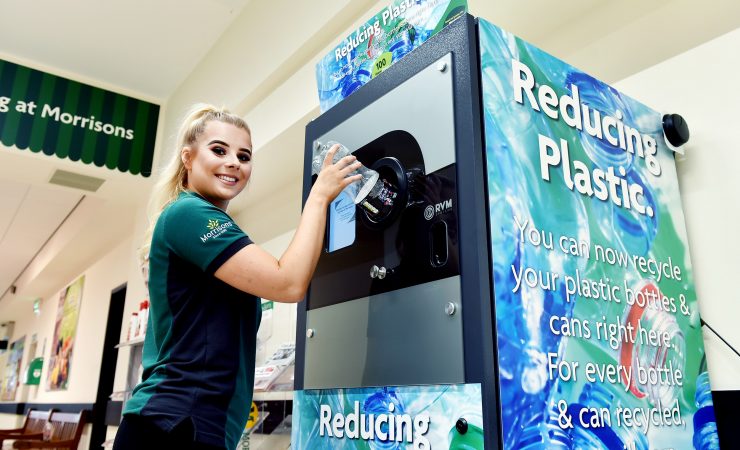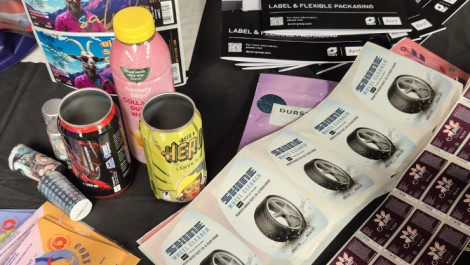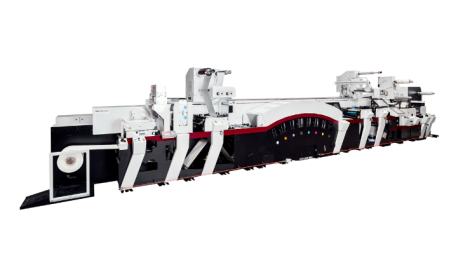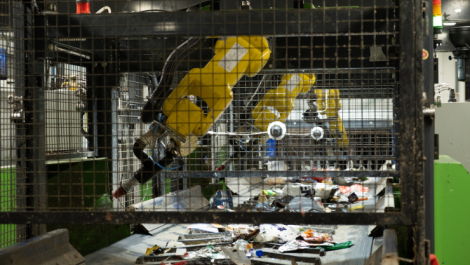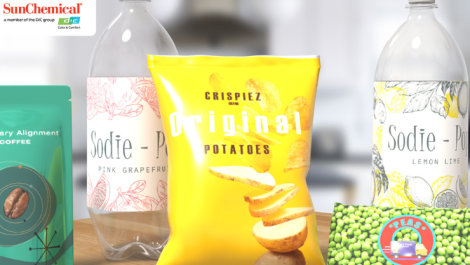A year on from the public outrage triggered by Sir David Attenborough’s Blue Planet revelations, a more measured response is emerging to the role of plastics in food packaging, reports Des King.
Whilst no one would go so far as to say the tide turning in favour of plastic packaging, the debate over its widespread use – with especial reference to the 40,000 different SKUs on display in the larger supermarket outlets – has definitely taken on a more balanced tone. This time last year, plastic as the material of choice for anything and everything, from a bottle of Coke to a bag of courgettes, looked to be dead in the water, with at least two retailers advocating its total prohibition from their own-label ranges. So visceral was the sense of outrage provoked by the images of marine life choking to death on plastic waste mistaken for small fry that it was nigh on impossible to mount any defence – not least that it was elements of the public at large, rather than plastic in general, that was responsible for the pollution displayed so graphically on the nation’s TV screens and newspaper front pages.
However, plastic packaging past its use-by date is now steadily being perceived as a potential resource rather than a waste of space. The government is widely expected to announce a series of measures aimed at regularising and demystifying the kerbside collection of household waste undertaken by the UK’s 380+ local authorities, which currently operate over 50 different schemes. Making the criteria for waste disposal simple and straightforward – and consistently applied, whether in Coventry or Carlisle – is the basis for repurposing it for future inclusion within the circular economy.
Whilst the general public will be encouraged to do its bit largely out of the goodness of its heart and its pricked conscience, financial incentives are equally likely to be introduced too, via anticipated reforms to the existing PRN (packaging recovery note) scheme by establishing a modulated fee structure that will encourage the design of recyclability into increased volumes of plastic packaging. Speaking at the Packaging Innovations exhibition (London Olympia) in September, the scheme’s original instigator Lord Debden noted, ‘If you have recycled content in your packaging, you should get credit for it by not paying so much towards the PRN. Similarly, if you have recyclable packaging then you should pay less than if you don’t, so we encourage the good and make the bad more expensive.’
Bags of improvement
Judging by steps taken by some of major multiples over the past few months, the direction of travel in terms of the usage of plastic packaging is increasingly veering towards ‘make the most of what there is’ rather than ‘doing without altogether’, but ideally in reduced volumes.
Some of the trimming back pre-dates the alarm sounded by Sir David Attenborough. So-called plastic bags have been a soft target for government and conservationists alike for a number of years; indeed the 5p charge was first introduced three years ago, since when usage by shoppers has fallen by 86% with an estimated 9 billion bags withdrawn from general circulation.
That charge is now expected to double to 10p, which should come as good news if not necessarily to consumers then to charities at least, since income derived from the ‘carrier bag tax’ dipped by 8% last year; a clear indication of how successful the scheme has been in persuading the public to switch to other means of bringing home the bacon and the rest of the shopping.
Tesco has been the most successful in reducing bag usage due to its insistence upon customers buying ‘bags for life’ instead. Of the other major multiples, Morrisons and the Co-op both recorded a 4% reduction in 2017, whilst sales via M&S and Waitrose levelled out. Conversely, sales of single-use plastic bags rose through both Sainsbury’s and particularly so Asda, where the uplift of over 27 million during the year has led them confirm they will be echoing Tesco’s example by instituting a total ban as of this coming January.
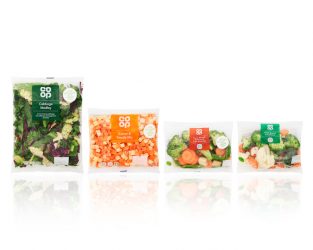
Recyclable PE film produced for the Co-op’s Freshtime vegetable offer
Morrison’s have followed suit. Meanwhile, Waitrose – in an attempt to kill two birds with the same stone, and perhaps with an eye to appealing to its customers’ collective moral conscience – has introduced a £4 reusable bag made from recycled plastic bottles; a tacit acknowledgement that the recovery rate for all drinks packaging for on the go consumption is below 3% (an estimated 700,000 PET bottles being littered each day).
Despite weighing a fractional 0.02% of the estimated total volume of marine litter, plastic straws are almost on par with plastic bags as public enemy number one in the war against waste, making them another easily identifiable target for supermarkets to aim at. Asda is phasing out an estimated 2.4 million of them from its in-store cafés by the end of the year and replacing them with biodegradable paper alternatives. Morrisons is going the same route; likewise Waitrose, which is also axing disposable coffee cups. Pretty well every major supermarket has already put a complete stop on the use of plastic in own-label ear buds.
Progress down the aisle
To a certain extent all of the above amounts to not much more than window-dressing. It is estimated by the environmental consultancy Eunomia that supermarkets generate over 800,000 tonnes of plastic waster per annum, so there is plenty to go at. Accordingly, the serious action is focused upon the use of plastic packaging across all own label categories, and in particular fresh produce and products for convenience and on the go consumption.
M&S and the Co-op have consistently maintained commitment towards delivering a more sustainable consumer experience in recent years; the former with its Plan A blueprint within which the latest initiative being to reduce the number of different types of plastic it uses to a single one by 2025 – currently tipped to be PEF (polyethylene-furanoate), being developed by a BASF-led consortium as a bio-based alternative to PET.
In the meantime, M&S has pledged to ensure its total plastic packaging is ‘widely recyclable’ by 2022. The Co-op aims to be there by 2023 (and 80% towards its target by 2020), and has just adopted a fully recyclable PE film developed by Coveris across a range of its Freshtime produced prepared vegetable lines. Other measures taken to improve recyclability including replacing black or grey trays with clear PP ones for its pan-Asian and India ready-meals; and bottling its edible oils, chilled juices and dilutable soft drinks in 50% rPET – as well as for still and sparkling water irrespective of any slight discolouration on-shelf.
Other commitments towards a 100% recyclable future include Asda by 2025 – the same year by which Waitrose has committed to making all its own-label packaging ‘widely recyclable’, reusable or home compostable –and most ambitiously of all, Morrisons by 2020. Meanwhile, Tesco has committed to removing all packaging which is ‘hard to recycle’ from the chain’s own-brand products by the end of 2019.
Reduction, meanwhile, continues apace. Asda is already halfway towards removing 6500 tonnes of plastic packaging from its own-brand offer, and is looking particularly closely at fresh produce; identified by 50% of its consumers as the category within which they would most like to see reductions made. ‘There’s this belief that carrots have to be straight and cucumbers have to be curved, but look how the wonky veg box has boomed, so much so that they’ve struggled to keep up with demand for it,’ said senior packaging buying manager Shane Monkman, whilst also noting that there are potential risks. A swede may be sufficiently robust for sale in its natural state; soft fruit, however, is a different proposition.
‘We are trialling this strategy in some stores and with some produce now to see quite how far we can go – but likewise we’re keeping an eye on wastage as that’s a direct cost to the business, and the environment too. Consumers rummage around in the trays; others dislike the thought of their potential purchases being touched so they want it wrapped. Also you can lose the benefit brought by the plastic packaging in preserving the produce, so eliminating it on a blanket basis isn’t necessarily the answer.’
Asda is one of several multiples to be trying to directly engage consumers in the whole plastic packaging and waste debate: its Plastic Ideas Hub launched this year offers a £10,000 award for every ‘scaleable, workable’ innovation aimed at tackling its challenges. Meanwhile, both Morrisons and Iceland are trialling the use of deposit return scheme (DRS) units in selected stores.
Can’t believe it’s not …
Now that calmer heads are addressing the issue, what price the plastic-free aisle? Ahead of the pack with an initial trial in February, the Dutch retailer Ekoplaza has now installed plastic-free aisles displaying over 2000 SKUs throughout its entire chain of 74 stores.
Equally keen on this approach has been Iceland, which along with Ekoplaza has also backed a scheme to feature a front-of-pack symbol that instantly informs customers at the point of purchase that packaging is plastic-free – and with bananas secured with a recyclable paper band the first product to be sold bearing this accreditation.
Whilst it still aims to be plastic-free by 2023 – and indeedhas removed 850 tonnes of plastic from its own label packaging, mainly by the replacement of black plastic with paper-based trays for frozen meals – the retailer may, however, be softening its position slightly. ‘Where we’re coming from is ‘no plastics’; so even though we may have to have some plastics and we may come back to that, that’s not where we’re starting from. In that respect flexibles is the most difficult thing to do unlike moving from a plastic tray to one made out of board. Substituting a PE oil-based film with a non-plastic solution is nowhere near as easy,’ said Iceland Food’s own label and packaging manager Ian Schofield.
He continued, ‘Raw material suppliers like BASF or Novamont in Italy have some solutions, for example, paper-based laminates that might work with a lot less plastic in it or no plastic at all – or alternatively going back to cellulose and paper. Manufacturers like Parkside have done loads of work on this already; they’re very confident about their products becoming solutions. Yes, they are more expensive but that doesn’t mean it will cost more overall in the long run if we all collaborate together.
‘In the main, however, we’ve talked to all the converters but there aren’t many coming back with the answers I’m afraid to say. They could do a hell of a lot more. I’ve found more materials than they have. We’re going through trials on all sorts of materials at the moment; some completely plastic-free, some with massively reduced plastic content. It shouldn’t be left to the retailers to find these, however, it should be down to the converters.
‘For our part, insisting upon havingreally long shelf life on some products is something retailers like us might have to rethink. Do we need all these gases involved, do we need all these extended shelf lives?’
Meanwhile, should the government come up with a widely hoped for improved waste recovery strategy would Iceland go as far as rethinking its current position on plastics? ‘Of course we would,’ said Mr Schofield.‘We pay the PRN note every year; we never see that money again. We want to see it go back into recycling materials. If somebody said we’ve got a great way of making sure that every bit of single-use plastic is going to go into recycling that would suit us down to the ground. That would be a really good solution.

